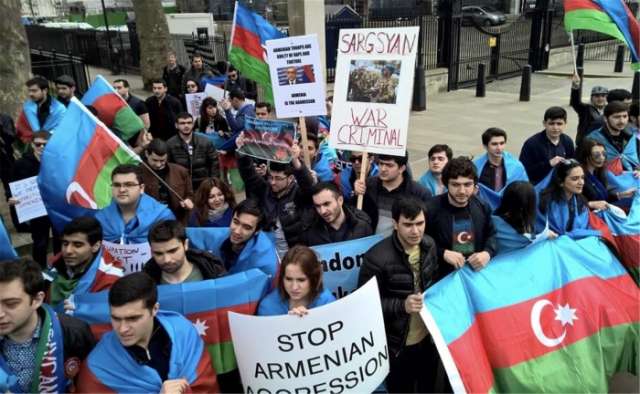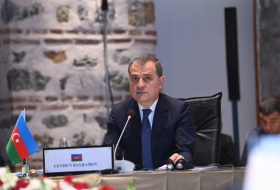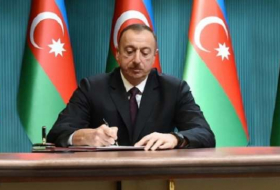On 22 February 1988, near the town of Asgaran on the Khankandi-Aghdam highway, the Armenians opened fire on a peaceful demonstration by the Azerbaijanis protesting against the above-mentioned decision of the Soviet of People’s Deputies of the NKAO. Two Azerbaijani youths lost their lives in consequence, becoming the first victims of the conflict.
On 26-28 February 1988, twenty-six Armenians and Azerbaijanis were killed as a result of the disturbances in Sumgait. It is notable that one of the leading figures in these events was Edward Grigorian, an Armenian and native of Sumgait, who was directly involved in the killings and violence against the Armenians and the pogroms in the Armenian neighborhoods. By decision of the Criminal Division of the Supreme Court of the Azerbaijan SSR dated 22 December 1989, Grigorian was sentenced to 12 years’ imprisonment. The Court found Grigorian to be one of the organizers of the unrest and massacres. Depositions by witnesses and victims show that he had a list of flats inhabited by the Armenians and together with three other Armenians, called for reprisals against the Armenians, in which he took part personally. His victims (all Armenians) identified Grigorian as one of the organizers and active figures in the violence. In fact, events in Sumgait being necessary to the Armenian leadership as a mean of launching an extensive anti-Azerbaijani campaign and justifying the ensuing aggressive actions against Azerbaijan had been planned and prepared in advance.
During 1988-1989 the Azerbaijanis were forced to leave Armenia. In the course of mass deportation at least 216 Azerbaijanis were killed and 1,154 people were wounded. The refugees from Armenia — eventually numbering approximately 200,000 people — began to arrive in Azerbaijan.
On 23 September 1989, The Supreme Soviet of the Azerbaijan SSR adopted the Constitutional Law “On Sovereignty of the Azerbaijan SSR,” 5th provision of which provided, inter alia, “that sovereignty of the Azerbaijan SSR shall cover the whole its territory, including Azerbaijan’s integral parts – Nakhchyvan ASSR and NKAO”, and that “the borders of the Azerbaijan SSR with other Union Republics might be altered only by mutual agreement of republics concerned.”
On 1 December 1989, the Supreme Soviet of the Armenia SSR adopted a resolution on the re-unification of the Armenian SSR and Nagorno-Karabakh.
On 10 January 1990, the Presidium of the Supreme Soviet of the USSR adopted the Resolution “On incompatibility of the acts of the Supreme Soviet of the Armenian SSR concerning Nagorno-Karabakh with the Constitution of the USSR”, where it was stated the unlawfulness of the unification of the Armenian SSR and Nagorno-Karabakh without the consent of the Azerbaijan SSR.
On 20 January 1990, with the approval of the Soviet leadership under Mikhail Gorbachev, the Soviet army units were dispatched to Baku. Their reprisals, which were conducted with uncommon savagery, left hundreds of innocent Azerbaijani citizens dead and wounded.
In 1991, the central law-enforcement agencies of the then USSR apprehended dozens of the Armenian armed groups that operated outside Nagorno-Karabakh. Thus, Chaykand village of the Khanlar district of Azerbaijan was turned by the Armenian armed groups into a criminal hub from which they bombed and shelled surrounding villages and roads, terrorizing the local Azerbaijani population. From 1989 to 1991, in Chaykand and adjacent areas only 54 people fell victim to the Armenian armed groups. In 1992, Azerbaijan regained its control over Goranboy district.
On 30 August 1991, the Supreme Soviet of Azerbaijan, having regard to the Constitutional Law of 23 September 1989, declared the restoration of state independence established in 1918 by the ADR.
On 2 September 1991, the joint session of the Nagorno-Karabakh regional and Shaumian district Soviet of People’s Deputies declared the establishment of “the Nagorno-Karabakh Republic” within the borders of the NKAO and Shaumian district of Azerbaijan.
The Constitutional Act “On State Independence of the Republic of Azerbaijan”, adopted on 18 October 1991, established political and economical foundations of the Republic of Azerbaijan.
On 26 November 1991, the Supreme Soviet of the Republic of Azerbaijan adopted a Law “On the Abolition of the Nagorno-Karabakh Autonomous Oblast of the Republic of Azerbaijan”.
At the end of 1991 and the beginning of 1992 the conflict turned into a military phase. Taking advantage of the political instability as a result of the dissolution of the Soviet Union and internal squabbles in Azerbaijan, Armenia initiated combat operations in Nagorno-Karabakh helped with external military assistance.
In February 1992, an unprecedented genocide was committed against the Azerbaijani population in the town of Khojaly. This bloody tragedy, which became known as the Khojaly genocide, involved the extermination or the capture of thousands of Azerbaijanis; the town was razed to the ground. Over the night from 25 to 26 February 1992 the Armenian armed forces with the help of the infantry guards regiment № 366 of the former USSR implemented the seizure of Khojaly. The inhabitants of Khojaly remained in the town before the tragic night (about 2,500 people) tried to leave their houses after the beginning of the assault in the hope to find the way to the nearest place populated by the Azerbaijanis. But these plans have failed. Invaders destroyed Khojaly and with particular brutality implemented carnage over its peaceful population.
Brutal annihilation of hundreds of defenseless inhabitants of Khojaly was one of the most heinous crimes during the armed conflict in and around the Nagorno-Karabakh region of the Republic of Azerbaijan. The Armenian armed forces and foreign military units spared virtually none of those who had been unable to flee Khojaly and the surrounding area. As a result, 613 persons were killed, including 106 women, 63 children and 70 elderly people. 1,275 inhabitants were taken hostage, while the fate of 150 persons remains unknown to this day. In the course of the tragedy 487 inhabitants of Khojaly were severely maimed, including 76 children not yet of age. 6 families were completely wiped out, 26 children lost both parents, and 130 children one of their parents. Of those who perished, 56 persons were killed with especial cruelty: by burning alive, scalping, beheading, gouging out of eyes, and bayoneting of pregnant women in the abdomen.
Armenian officials deny their responsibility for the crimes committed during the conflict, including against the population of Khojaly, airily falsifying facts and sharing their own interpretations of them, which deviate not only from reality but also from elementary logic. Nevertheless, even the subtlest propaganda will never manage to disprove the facts that speak of a situation diametrically opposite to that represented by the Armenian side.
Apart from the considerable information in possession of the law-enforcement agencies of the Republic of Azerbaijan, the responsibility of Armenia is documented also by numerous independent sources and eyewitnesses of this tragedy as well as is acknowledged by the direct perpetrators of the genocide.
Thus, for example, Markar Melkonian, brother of the well-known international terrorist Monte Melkonian, while considering what has happened in Khojaly simply as a consequence of “discipline problems” and “insubordination” among Armenian military units, testified the following:
At about 11:00 p.m. the night before, some 2,000 Armenian fighters had advanced through the high grass on three sides of Khojaly, forcing the residents out through the open side to the east. By the morning of February 26, the refugees had made it to the eastern cusp of Mountainous Karabagh and had begun working their way downhill, toward safety in the Azeri city of Agdam, about six miles away. There, in the hillocks and within sight of safety, Mountainous Karabagh soldiers had chased them down. “They just shot and shot,” a refugee woman, Raisa Aslanova, testified to a human Rights Watch investigator. The Armenian fighters had then unsheathed the knives they had carried on their hips for so long, and began stabbing.
Now, the only sound was the wind whistling through dry grass, a wind that was too early yet to blow away the stench of corpses.
Monte crunched over the grass where women and girls lay scattered like broken dolls. “No discipline”, he muttered. He knew the significance of the day’s date: it was the run-up to the fourth anniversary of the anti-Armenian pogrom in the city of Sumgait. Khojaly had been a strategic goal, but it had also been an act of revenge.
In his book “Black Garden: Armenia and Azerbaijan through peace and war”, the British journalist Thomas de Waal makes references to words of the Armenian militaries. Thus, “[a]n Armenian police officer, Major Valery Babayan, suggested revenge as a motive. He told the American reporter Paul Quinn-Judge that many of the fighters who had taken part in the Khojaly attack “originally came from Sumgait and places like that”.
But the most important was that the recently elected President of Armenia Serzh Sargsyan said of what had had happened:
Before Khojaly, the Azerbaijanis thought that they were joking with us, they thought that the Armenians were people who could not raise their hand against the civilian population. We were able to break that [stereotype]. And that’s what happened. And we should also take into account that amongst those boys were people who had fled from Baku and Sumgait.
As Thomas de Waal sums up, “Sargsyan’s account throws a different light on the worst massacre of the Karabakh war, suggesting that the killings may, at least in part, have been a deliberate act o mass killing as intimidation”.
The facts mentioned above confirm that the intentional slaughter of the Khojaly town civilians on 25-26 February 1992, including children, elderly and women, was directed at heir mass extermination only because they were Azerbaijanis. The Khojaly town was chosen as a stage for further occupation and ethnic cleansing of Azerbaijani territories, striking terror into the hearts of people and creating panic and fear before the horrifying genocide.
In May 1992, Shusha, the Azerbaijani-populated administrative centre of the region within Nagorno-Karabakh and Lachyn, the region situated between Armenia and Nagorno-Karabakh, were occupied. In 1993, Armenian armed forces captured another six regions of Azerbaijan around Nagorno-Karabakh: Kalbajar, Aghdam, Fuzuli, Jabrayil, Gubadly and Zangilan.
Contrary to numerous statements of the official Yerevan that Armenia is not directly involved into the conflict with Azerbaijan, there are indisputable proofs, which testify against such allegations and argue for the direct military aggression of the Republic of Armenia against a sovereign state.
There are ample evidences proving participation of the Armed Forces of the Republic of Armenia in the hostile actions against Azerbaijan. Since, the scope of this report prevents from providing complete list of available evidences, below are just a few well-documented facts of direct military actions of Armenia.
Thus, in January 1994 the Armed Forces of Azerbaijan defeated the sub-divisions of the separate motor-rifle regiment №. 555 (Army unit No. 59016) of the Republic of Armenia in the combat and captured several Armenian soldiers. According to the documents seized in the wake of the combat operation, one of the units of this regiment made a dash in April 1993 from the town of Vardenis in the Republic of Armenia to Kalbajar region of Azerbaijan with the purpose of backing-up the group of Armenia’s occupation forces in this part of Azerbaijan.
Among the trophy captured during the combat operations in Kalbajar region of Azerbaijan there were combat maps with battle-orders addressed to the commander of the separate motor-rifle regiment № 555 and to the head of the operational group, signed by the Chief of Staff of the Armed Forces of the Republic of Armenia, lieutenant-general G.Andresian, as well as working combat maps of the officers of the 3rd motor-rifle battalion of the 3rd separate motor-rifle brigade of the Armed Forces of the Republic of Armenia. These maps are marked on with hand-written decision to launch an assault and seize Kalbajar region of Azerbaijan on 1 April 1993.
Azerbaijani troops seized also many personal documents of the citizens of the Republic of Armenia drafted into the military and sent to Azerbaijan to participate in the combat operations. Among them are national passports, military ID’s issued by the different drafting bodies of the Republic of Armenia (“military commissariats”), call-up papers for joining military service and participation in the military musters issued by drafting bodies of different districts of the Republic of Armenia, official ID’s of employees of the Ministry of Interior and the Ministry of Defense of the Republic of Armenia, special contracts for the service in the Armed Forces of the Republic of Armenia, travel warrants, petitions for conferring military ranks, drafting warrants, leave warrants and vocation passes.
In 1992-1994, Armenian Armed Forces occupied administrative districts of the Republic of Azerbaijan as follows:
May, 1992 – Shusha district;
May, 1992 – Lachyn district situated between the former NKAO and the Republic of Armenia;
April, 1993 – Kalbajar district (between the former NKAO and Armenia, to the north of Lachyn);
July, 1993 – Aghdam district;
August, 1993 – Fuzuli district;
August, 1993 – Jabrayil district;
August, 1993 – Gubadly district;
October, 1993 – Zangilan district.
On 30 April 1993, the UN Security Council adopted Resolution № 822, demanding immediate withdrawal of all occupying forces from Kalbajar and other recently occupied areas of Azerbaijan.
On 29 July 1993, the UN Security Council adopted Resolution № 853, which demanded “the immediate, complete and unconditional withdrawal of occupying forces involved from the district of Aghdam and other recently occupied districts of the Republic of Azerbaijan”.
On 14 October 1993, the UN Security Council adopted Resolution № 874, which called for “immediate implementation of the reciprocal and urgent steps provided for in the CSCE Minsk Group's adjusted timetable, including the withdrawal of forces from recently occupied territories”.
On 11 November 1993, the UN Security Council adopted Resolution № 884, which condemned the occupation of Zangilan district and Horadiz town, attacks on civilians and bombardments of the territory of the Republic of Azerbaijan and demanded the unilateral withdrawal of occupying forces from Zangilan district and Horadiz, and the withdrawal of occupying forces from other recently occupied territories of the Republic of Azerbaijan.
In sum, the ongoing armed conflict in and around the Nagorno-Karabakh region of the Republic of Azerbaijan has resulted in the occupation of almost one-fifth of the territory of Azerbaijan and made approximately one out of every eight persons in the country an internally displaced person or refugee, 20,000 people were killed, 50,000 people were wounded or became invalids, about 5,000 citizens of Azerbaijan are still missing.
The aggression against the Republic of Azerbaijan has severely damaged the socio-economic sphere of the country. In the occupied territories 871 settlements, including 11 towns, 848 villages, hundreds of hospitals and medical facilities have been burned or otherwise destroyed. Hundreds of thousands of houses and apartments, thousands of social and medical buildings have been destroyed or looted. Hundreds of libraries have been plundered, a great deal of valuable manuscripts have been burned or otherwise destroyed. Several State theatres, hundreds of clubs and dozens of musical schools have been destroyed. Several thousands of manufacturing, agricultural and other kinds of factories and plants have been pillaged. Hundreds kilometers-long irrigation system have been totally destroyed. Flocks of several hundreds of thousands of sheep and dozens of thousands of cattle have been driven out of the occupied territories to Armenia.
About 70% of summer pastures of Azerbaijan remain in the occupied zone. The regional infrastructure, including hundreds of bridges, hundreds of kilometers of roads and thousands kilometers of water pipelines, thousands kilometers of gas pipelines and dozens of gas distribution stations, have all been destroyed.
The war against Azerbaijan has also had catastrophic consequences for its cultural heritage both in the occupied territories and in Armenia.
According to the preliminary data, the overall damage inflicted on the Republic of Azerbaijan as a result of Armenian aggression is estimated to be tens of billions USD.
On 12 May 1994, the ceasefire was established. However, Armenia continues to violate the truce. Since summer of 2003 there has been an acute increase in ceasefire violations by the Armenian side. In addition to shelling and killing Azerbaijani soldiers along cease-fire line, Armenians also attack civilians in the adjacent territories.
More about: #Armenia #Azerbaijan #Karabakh













































